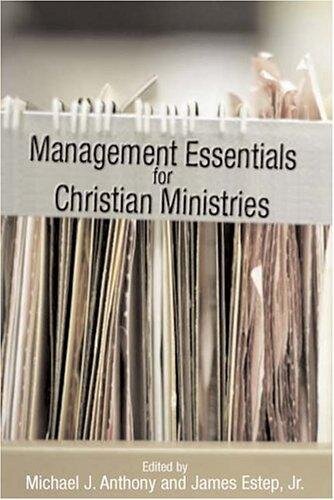Michael J. Anthony and James Estep, Jr., Editor, Management Essentials for Christian Ministry. Broadman and Holman, 2005.
Referenced in:
LifeandLeadership.com Summary
On the subjects it covers, this is one of the best church administration manuals available. The title well expresses the content of this book, i.e. it is not as broad as other church administration texts that address office, facilities, church events, etc. Instead, it focuses on the administrative and organizational dimensions of effective congregational leadership and development. Its 23 chapters and 400+ pages are divided into six sections:
1. Integration – Offers biblical and theological perspectives on management. The arguments are strained at times (e.g. finding themes of planning and organization in Jesus’ parables?), but overall quite helpful. The theology of administration emphasizes “the purpose of Christian administration is not the increase in workers’ efficiency, effectiveness and/or productivity (viewing workers as means to ends) but rather, the transformation of individuals as the end, aiding them in personal growth in the community of faith. Ministry leaders administrate for a spiritual reason and for a spiritual purpose, not for bureaucratic or mere institutional necessities.” (43)
2. Planning – This is probably the most helpful section of the book. It lays out useful procedures for standard strategic planning processes including mission, vision, goals, objectives, policies, procedures, budgeting and ministry by objectives. Several pieces here are excellent. For example, it includes perhaps one of the best summaries available of the five budgeting models (incremental, zero-based, PPBS, formula, cost or responsibility-centered) and six stages of budget development. Other gems are tucked within such as the S.M.A.R.T. test for goals (95). Also, in the chapter on policies and procedures, they make a good philosophical and practical argument for balancing planning and the moving of the Spirit.
3. Organizing – Covers how to design and implement the best organizational structure for one’s purposes, contending that no one organizational structure fits every ministry context. This section is weighted more toward denominational structures and less toward congregational structures. It also discusses position (job/role) descriptions, conducting effective meetings, congregational change (e.g. organizational life cycle theory), decision-making and communicating. Each of the chapters is content rich and practical.
4. Staffing – Discusses how to recruit and screen volunteers, develop staff members. Also covers standard legal and ethical considerations for ministry.
5. Directing – developing leaders, mentoring in ministry, transforming groups into teams, leadership strategies, and board development.
6. Evaluating – Gives instruction on how to conduct performance reviews and evaluate the effectiveness of programs.
The strength of this text is the section on theology of administration and planning. Also, their suggestions are not heavily influenced by one denominational model, though participants in elder-led churches may find less help than they want (typical of church administration manuals).
About the Authors
Anthony is professor of Christian Education at Biola University/Talbot School of Theology and visiting professor of Christian Education at Southern Baptist Theological Seminary. Estep is professor of Christian Education and director of academic assessment and faculty development as well as associate dean of Christian Ministries at Lincoln Christian College and Seminary.
***For additional information on this resource, including reviews, click the bookstore links. Check the reference at page top or the links below for resource guides on related topics.***
Other Ministry Resource Guides on Church Administration:
See Resources on Over 100 Areas of Ministry Leadership:


